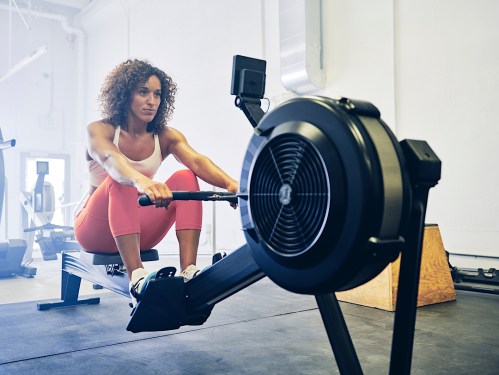‘I’m a Rowing Coach, and This Is Why You’re Getting Wrist Pain From Rowing—Plus How To Avoid It’
A certified trainer shares her best tips and tricks to help with wrist pain from rowing so you can go the distance.

Rowing is having a moment right now—and for good reason. A rowing machine engages 86 (!) percent of your muscles, making it an incredibly effective, low-impact form of aerobic exercise that’s good for your heart health and cardiorespiratory fitness.
Experts in This Article
certified personal trainer, senior master coach at Row House
One challenge: Whether you’re using a rowing machine at home (like the Hydrow, Aviron or Ergatta), the gym, or a studio dedicated to rowing workouts, it’s common to experience wrist pain from rowing at some point, especially when you’re still getting the hang of your stroke.
“If people are feeling pain in their wrist, it is likely a technique issue—gripping the handle too hard, starting the stroke with a ‘pull’ of the arms first rather than a push of the legs, or finishing with the handle too high and flexing through the wrist,” says Michelle Parolini, CPT, a senior master coach for Row House. So working on your form is key.
“Step one: Check your grip,” Parolini says. “The handle should always be hanging in your fingertips with your arms hanging like cables.” By this she means they should be long, but with a bit of tension in them.
“Step two: Check the stroke sequence,” she says. “Pushing with the legs, opening the hips, and then finally pulling with the arms—arms should only be about 10 percent of the stroke.”
“Step three: Ensure that you’re bracing through your core and engaging the lats all the way through the finish. Your wrist should be in line with the forearm, elbows back and the handle stops at the sternum—not pulling too high, causing a bend through the wrists.” Parolini says to think about balancing a bottle of water on your wrist at the finish.
Want to row at home?

Hydrow Wave Rower — $1,545.00
Originally $1,695, now on sale for $1,545
ThirdLove Just Launched Bras That Help Balance Your Body Temperature—Here’s Why That’s a Game-Changer for Women in All Life Stages

These Are the Only Types of Underwear You Should Be Wearing, According to Gynecologists

These Are the Summer Essentials You Should Bring With You Every Time You Leave the House, According to a Derm and an RD

Aside from form, Parolini has two more tips for addressing wrist pain from rowing
1. Strengthen your core and back muscles
Part of rowing with proper form involves making sure you’re engaging the correct muscle groups and not letting your wrists bear the brunt of all that force as you pull. “Strengthening through the core, including the lats, will help with core engagement on the drive,” Parolini says. “Bracing through the core will allow someone to hang from the handle rather than muscle it.”
Any core and back workouts will help you build strength in these areas, but Parolini particularly recommends band pull aparts to strengthen the lats. “They also allow for strengthening through the shoulder joint,” she adds. “And forearm planks will help train stabilization in the torso, something that’s critical for a strong drive.”
Here’s how to do a forearm plank with proper form:
2. Stretch before and after workouts
Stretching is one of the best ways to make sure that your wrist joints—as well as the muscles and tendons surrounding them—maintain their proper length-tension relationships, meaning they’re all in their optimal positions and no part of the group is working harder than it should. There are three stretches that Parolini particularly likes for rowers.
- 1.Wrist extensor stretch: Bring the palms of the hands together in a prayer position. Slowly lift your elbows while lowering your hands toward your waist to stretch the underside of your wrist.
- 2.Figure-eights: Interlace your fingers. Keeping your elbows tucked into your sides, move your hands in a figure-8 pattern in both directions.
- 3.Finger stretches: Make a fist with both hands and squeeze as tight as possible, then open and spread your fingers as far apart as possible.
Aim to do at least 30 seconds of each stretch as part of a dynamic warm-up prior to hopping on your rower, and consider spending some dedicated time to stretching your wrists regularly.
This wrist workout is a good place to start:
Sign up for the Well+Good SHOP Newsletter
Get exclusive deals on wellness, beauty, fitness, and food products that have been hand-picked by our editors.
Got it, you've been added to our email list.







